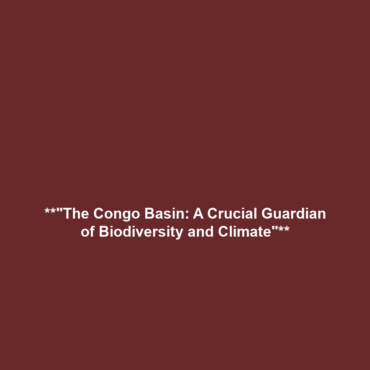The Importance of the Congo Basin in Biodiversity and Climate Regulation
Introduction
The Congo Basin, as the second-largest tropical rainforest in the world, plays a crucial role in maintaining biodiversity and regulating the Earth’s climate. Covering a vast area across several countries, including the Democratic Republic of Congo, Cameroon, and Gabon, this rainforest is home to a remarkable variety of plant and animal species. Unfortunately, it is increasingly threatened by deforestation, driven by agriculture, logging, and mining, which contribute to biodiversity loss. The significance of the Congo Basin cannot be understated, as its health directly impacts global climate patterns and the survival of numerous species.
Key Concepts
Understanding the Congo Basin’s importance requires an exploration of major concepts relating to deforestation and biodiversity loss. Here are the key principles:
-
Biodiversity Hotspot
The Congo Basin is recognized as one of the world’s biodiversity hotspots, containing over 10,000 species of tropical plants, with about 30% being endemic. This rich biodiversity is essential for ecosystem stability and resilience.
-
Carbon Sequestration
The forest acts as a significant carbon sink, absorbing carbon dioxide from the atmosphere and helping mitigate climate change.
-
Watershed Protection
The Congo Basin plays a pivotal role in water management, influencing rain patterns and maintaining hydrological cycles that support agriculture and communities.
Applications and Real-World Uses
The significance of the Congo Basin goes beyond ecological functions—it has practical applications in several areas:
- How the Congo Basin is used in Climate Regulation: The rainforest’s vast coverage helps in stabilizing local and global climates through its role in carbon cycling.
- Applications of Biodiversity in Sustainable Development: Many indigenous communities depend on the forest resources for their livelihoods, including food, medicine, and raw materials.
- Ecotourism Potential: The biodiversity of the Congo Basin attracts tourism, which, if managed sustainably, can generate revenue while promoting conservation.
Current Challenges
The study and application of the Congo Basin face several challenges:
- Deforestation Trends: Rapid deforestation driven by illegal logging and land conversion presents significant problems.
- Political Instability: Ongoing conflicts in the region can hinder conservation efforts and effective policy implementation.
- Limited Research Funding: Insufficient funding and resources for scientific research restrict comprehensive biodiversity assessments.
Future Research and Innovations
Future research and innovations in the Congo Basin could lead to breakthroughs in understanding and mitigating Deforestation and Biodiversity Loss:
- Remote Sensing Technology: Innovations in satellite imaging allow for better monitoring of forest health and tracking illegal deforestation activities.
- Restoration Ecology: Research into reforestation techniques to counteract past deforestation impacts may enhance habitat recovery.
- Community-Based Conservation: Engaging local populations in sustainable practices may lead to more effective biodiversity preservation strategies.
Conclusion
In summary, the Congo Basin serves as a critical component for biodiversity and climate regulation. Addressing the challenges of Deforestation and Biodiversity Loss is imperative not just for the region but for the global community at large. Continuing to invest in research, advocacy, and sustainable management practices is essential to protect this invaluable resource for future generations. For more information on related topics, visit our pages on biodiversity conservation and sustainable forestry practices.

Leave a Reply